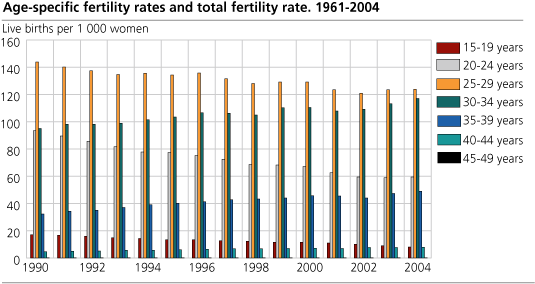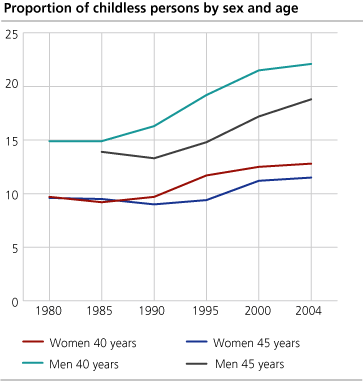Content
Published:
This is an archived release.
Teenage fertility at historic low
In 2004, the fertility rate of teenage mothers continued to fall and has now come to a historic low. On average, women aged 15-19 years gave birth to 8.2 children per 1 000 women last year. This is half as many as in the beginning of the 1990s. Thirty years ago there were five times as many teenage mothers as today.
57 000 children were born in 2004, and the total fertility rate (TFR) was 1.83 children per woman. The fertility rate has been relatively stable since the late 1980s.
In 2004, the average age of first-time mothers was 28.0 years. With 123.9 children per 1 000 women, women aged 25-29 had the highest fertility rate. In recent years, however, it has become increasingly common for women to give birth in their thirties. The fertility rate for women aged 30-34 was 117.1 per 1 000 women, and 49.1 per 1000 women aged 35-39.
Highest fertility rate in western Norway
The two counties Sogn og Fjordane and Møre og Romsdal had the highest fertility rate in 2004, whereas Oppland, Hedmark, Vestfold and Østfold had the lowest fertility rate.
Compared with 2003, the majority of the counties experienced a slight rise in fertility. Nevertheless, there was a fall in fertility in Hedmark, Oppland, Sogn og Fjordane, Nord-Trøndelag and Troms. Aust-Agder had the largest increase in fertility. Following some years of below average fertility rates, Aust-Agder's fertility rate is now average.
More childless men than women
The proportion of men without children was higher than the proportion of women without children in 2004. Among 40-year-old women 12.8 per cent did not have children. For men this figure was 22.1 per cent. At the age of 45 the difference in childlessness was smaller, as 11.5 per cent of women and 18.8 per cent of all men did not have any children at this age.
In the past twenty years the proportion of people without children has increased steadily - for both women and men. Nevertheless, the increase for men has been more than twice as high as for women. Since 1985, the proportion of childless people has risen by 2 per cent for women and 4.9 per cent for men.
Tables:
- Table 1 Live births and late foetal deaths. 1951-2004
- Table 2 Live births, by month. 1971-2004
- Table 3 Confinements of single and multiple births. 1956-2004
- Table 4 Confinements of single and multiple births, by sex. 1991-2004
- Table 5 Age-specific fertility rates and total fertility rate. 1961-2004
- Table 6 Average age at birth. 1946-2004
- Table 7 Mean age of parents at all birth, by county. 2004
- Table 8 Total fertility rate, by county. 1968-2004
- Table 9 Live births, by parity. 1978-2004
- Table 10 Live births, by county and municipality. 2004
- Table 11 Live births, by cohabitation status and county. 2001-2004
- Table 12 Live births, by parity, cohabitation status of mother and county. 2004
- Table 13 Mean age of mother and father and cohabitation status at birth of the child, by county, 2004
- Table 14 Number of children distributed, by age and cohort. Per cent (Updated 3 October 2005)
Contact
-
Statistics Norway's Information Centre
E-mail: informasjon@ssb.no
tel.: (+47) 21 09 46 42
-
Espen Andersen
E-mail: espen.andersen@ssb.no
tel.: (+47) 92 61 00 46
-
Ane Margrete Tømmerås
E-mail: ane.tommeras@ssb.no
tel.: (+47) 91 99 29 62
-
Oppdrag befolkningsstatistikk
E-mail: befolkning@ssb.no


